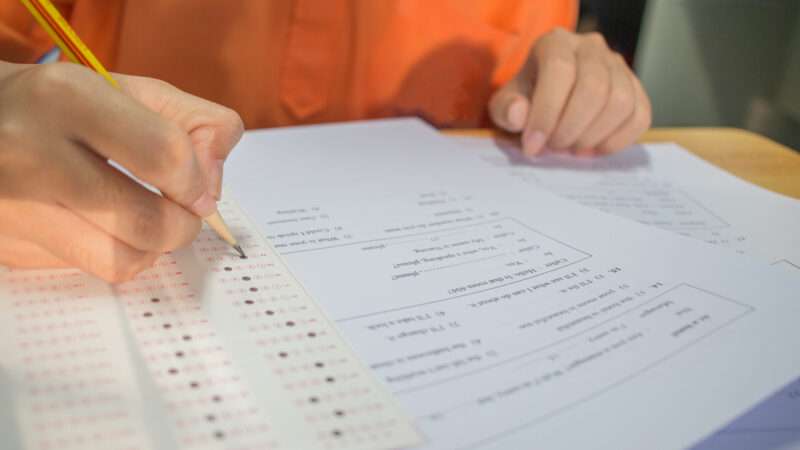
It seems many American high schoolers are not just unprepared for college; it appears they also lack the basic knowledge a high school education is meant to provide.
According to a recent report examining national ACT scores, American high school students’ ACT scores have dropped dramatically in the past year. The released data highlights the staggering fact that few high school students, even before the pandemic, are academically prepared to attend college. While the most recent decline shows the impact of COVID-era school closures on students’ learning, consistently low scores draw attention to the fundamental flaws at the core of many of America’s government-run schools.
The ACT, along with the SAT, is a college entrance exam used to measure students’ preparedness for undergraduate study at American universities. The test is broken down into four sections, covering reading, math, science, and English. Each section is awarded a score from 1 to 36, and the rounded average of the four scores is recorded as the student’s “composite score.” The test is most popular in the South and Midwest, while the SAT is preferred in east and west coast states (though it is common for motivated students to take both tests). While many colleges have dropped the test in recent years, citing equity and diversity concerns, the ACT and SAT remain cornerstones of the college application process—as well as commonly utilized measures of whether a student is academically prepared for college.
On Wednesday, the ACT, or the American College Test, released a report examining test takers’ performance over the past year. The average ACT score has consistently hovered just above 21 for the last decade. However, a steady decline began after the pandemic, with the average score falling to 20.3 in 2021 and 19.8 in 2022. The 2022 drop was particularly stark, as the half-point decline from 2021 marked the decade’s largest one-year drop in scores. According to the Associated Press, 2022 marks the first year since 1991 that the average ACT score dipped below 20.
While recent declines in student performance may appear small, its impact is a telltale sign of trouble in American high schools. “When we’re talking about over a million students, then seeing a half-point drop in one year is a big decline… We haven’t seen a change like that in the last 10 years or even in the last 30 years,” Rose Babington, senior director for state partnerships at ACT, tells Reason. “Seeing a change that’s not just 0.1 or 0.2 points from year to year is something that is definitely, definitely something we’re paying attention to. That being said,” she continued, “looking back to the past decade, two decades, three decades, this is part of a trend that, while more severe this year, has been happening for a long time.”
There was also a drop in the percentage of students meeting the ACT’s “College Readiness Benchmarks.” These benchmarks are minimum scores in each subject area, which are statistically correlated with success in freshman-level college courses. For example, a student must score at least a 22 on the mathematics section to meet the minimum level linked to success in college-level algebra. The percentage of students meeting all four benchmarks is down from 25 percent in 2021 to 22 percent in 2022 —also the largest decline of the decade. In all, 42 percent of test-takers met no ACT College Readiness Benchmarks in 2022.
“The score decline really reflects students’ lack of access to a rigorous high school curriculum… The scores themselves are really a direct reflection of the standards and skills that we want students to have to be successful in their freshman college courses,” Babington says. “So for us, the declines are telling this bigger story, that a lot of students don’t have access to the level of rigor that we’d like them to in high school.” She says this is especially true for low-income students or those from rural areas.
The low percentage of high school students meeting College Readiness Benchmarks is particularly concerning, especially as it appears that many students are attending four-year colleges despite not meeting the benchmarks. For example, in Alabama, only 15 percent of high school graduates met all four ACT College Readiness Benchmarks in 2020, yet 30 percent enrolled in a four-year college. This indicates that a significant proportion of Alabamian four-year college students were, in at least one core subject, unready to attend college by ACT measures.
It is incredibly troubling that thousands of American college students may be academically unprepared to succeed in higher education. Not only is this worrisome for the students themselves, who may end up dropping out of school because of academic struggles (while still being on the hook for some, if not all, of their student loans), but it also spells trouble for higher education as a whole, since universities might lower the rigor of many courses to avoid pushing students out.
The recent decline in ACT scores, coupled with their already staggeringly low pre-pandemic levels, shows just how deficient American schools are—particularly the government-run public schools which educate 91 percent of American students. For more students to succeed, we need to take a hard look at public schools and begin holding them to account for their failures.
The post Average ACT Scores Drop to Their Lowest Point in Three Decades appeared first on Reason.com.
from Latest https://ift.tt/y3eiGbw
via IFTTT